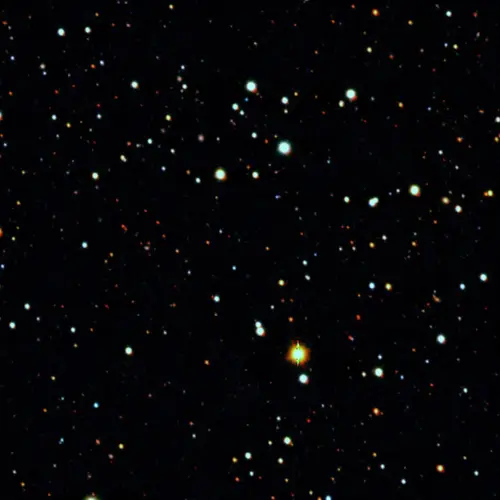Leading the Way
When a Star Gets Too Close to a Black Hole

Tidal disruption events, or TDEs, occur when a star gets too close to a supermassive black hole—objects with immense gravitational pull that are thought to lie at the center of most large galaxies. The black hole’s forces overwhelm the star’s gravity and tear it to shreds. Some of its material gets flung out into space and the rest falls back onto the black hole, forming a disk of hot, bright gas as it is consumed.
By observing the light given off during this process, which increases to a peak brightness and then tapers off, astronomers can better understand the physics of the black hole and the forces driving these violent encounters. Observatories NHFP Einstein Fellow Thomas Holoien leverages big data to study these fascinating phenomena, as well as supernovae and other so-called transient celestial events.

Courtesy of Carnegie Institute of Science.
In 2019, Holoien made a major breakthrough when he led the research team that discovered ASASSN-19bt using the the Ohio State University-based international network of telescopes of which he is a founding member called the All-Sky Automated Survey for Supernovae (ASAS-SN). The Holoien-led team then rapidly triggered follow-up observations of the newfound TDE using both space- and ground-based telescopes, including NASA’s Transiting Exoplanet Survey Satellite (TESS). Catching the event in the act enabled the astronomers to garner the most complete picture of this type of violent occurrence taken to date.
Although it was long thought that all TDEs looked the same, the team—which also included Carnegie’s Decker French, Konstantina Boutsia, Thomas Connor, Nidia Morrell, Andrew Newman, and Gwen Rudie, as well as Carnegie-Princeton Fellow Rachael Beaton—found that ASASSN-19bt was unusual in several of ways.

Its host galaxy is younger and more dust-filled than has previously been observed for other TDE events. Secondly, it experienced a short blip of cooling and fading before its temperature leveled off and its luminosity continued to build toward its peak. This information has improved astronomers’ ability to identify these phenomena and differentiate them from other celestial events that have a much choppier emission of light.
Holoien’s TDE expertise advanced again in 2021 when he was part of a research team that revealed a case of cosmic mistaken identity. They found that the discovery of a presumed supernova, called ASASSN-14ko, six years prior was actually periodic flaring from a galaxy more than 570 million light-years away where where a supermassive black hole gives off bursts of energy every 114 days as it tore off chunks of an orbiting star. Active galaxies, such as the host of ASASSN-14ko, have unusually bright and variable centers. This partial TDE was the first unambiguous example of such clockwork behavior from an active galaxy. The flares occurred when the lost material—equal to three times the mass of Jupiter at each pass—falls in towards the black hole. This rare find could help them understand the physics of these mysterious phenomena.
Islands of the Four Mountains Could be a Single Giant Volcano

The Islands of the Four Mountains in the central Aleutians is a tight group of six volcanos: Carlisle, Cleveland, Herbert, Kagamil, Tana and Uliaga. They are all what scientists call stratovolcanoes—steep conical mountains with a banner of clouds and ash waving at the summit, probably what most people would sketch if asked to draw a volcano.
Since the summer of 2015, current and former Carnegie seismologists and volcanologists, along with colleagues from a variety of institutions, have been studying Mount Cleveland—which is not only the most active member of the group, but one of the most active volcanoes in the entire Aleutian chain and arguably in North America since the turn of the century.

The researchers, including the Earth and Planets Laboratory’s Diana Roman, Lara Wagner, Hélène Le Mével, and Daniel Portner, as well as former postdoctoral fellow Helen Janiszewski, now at University of Hawaiʻi at Mānoa, have gathered multiple pieces of evidence indicating that the islands could, in fact, belong to a single interconnected caldera—a previously unrecognized giant volcano in the same category as Yellowstone.
Stratovolcanoes can experience powerful eruptions, such as that of Mount St. Helens in 1980. However, these events are dwarfed by the much rarer phenomenon of a caldera-forming eruption, which has potentially global consequences.

A caldera is created by tapping of a huge reservoir of molten rock, magma, in the Earth’s crust. When the reservoir’s pressure exceeds the strength of the crust, gigantic amounts of lava and ash are released in a catastrophic explosion. They are the most explosive type of volcanic events on Earth and their effects are often felt worldwide. The ash and gas they put into the atmosphere can alter Earth’s climate, and trigger social upheaval.
If confirmed, it would become the first known caldera in the Aleutians that is hidden underwater. But more evidence is needed to fully test the hypothesis. The team hopes to return to the Islands of the Four Mountains and look more closely at the seafloor, study the volcanic rocks in greater detail, collect more seismic and gravity data, and sample many more of the geothermal areas.

Aerial oblique photo of the volcanoes in the Islands of Four Mountains, Alaska. In the center is the summit of Mount Tana. Behind Tana are (left to right) Herbert, Cleveland, and Carlisle Volcanoes. USGS Photo by John Lyons, July 29, 2014.
The caldera hypothesis could help explain the frequent explosive activity seen at Mount Cleveland, which has produced ash clouds as high as 15,000 and 30,000 feet above sea level, posing a hazard to aircraft traveling between North America and Asia.
Cleveland’s volatility underpinned the project’s origin, which did not set out to find a possible caldera, but to better understand the volcano’s subterranean architecture. Funded by the National Science Foundation’s GeoPRISMS, the researchers deployed six seismometers and used an additional two permanent Alaska Volcano Observatory stations.
The findings also incorporated satellite-enabled remote sensing and historical data of the topography of the seafloor, which was critical to revealing the potential caldera, much of which is underwater.
Ancient Galaxies Formed in Dark Matter Halos

The Milky Way is surrounded by a cadre of orbiting dwarf galaxies—relics of the ancient universe. One of these dwarf galaxies, called Tucana II, is home to some of the most primitive known stars. A new technique developed by an MIT graduate student allowed a team of astronomers including Carnegie’s Joshua Simon, Lina Necib, and Alexander Ji to discover an unexpected outer suburb of stars on Tucana II’s distant fringes. Their detection confirmed that the cosmos’ oldest galaxies formed inside massive clumps of dark matter—what astronomers refer to as a “dark matter halo.”
Stars manufacture elements throughout their lifetimes, which they spread into the surrounding gas when they explode as powerful supernovae. These raw materials are then incorporated into new stars, making each successive stellar generation more chemically complex than its predecessors. As a result, astronomers know that stars containing very small amounts of most elements are incredibly old.
The newly discovered stars on Tucana II’s fringes are even more ancient than the ones close to its center, a phenomenon never previously observed in such a small dwarf galaxy. In larger galaxies, this type of distribution can be the remnant of a collision between two galaxies made up of stars of different ages. If a galactic merger is the source of this arrangement, these would be the smallest galaxies yet known to merge.

A model of a dwarf galaxy like Tucana II showing the expected dark matter as the shaded background and the stars in the galaxy as little bright dots. Before now, astronomers have only been able to see the denser clump of stars in the galaxy’s center. But thanks to the technique developed by MIT’s Anirudh Chiti, the researchers were able to detect the spray of stars on the edge of the simulation—the farthest out that they could expect to directly measure dark matter. Image from research published in the Monthly Notices of the Royal Astronomical Society (DOI: 10.1093/mnras/stz2887) courtesy lead author Coral Wheeler.
The spatial distribution of Tucana II’s stars is highly unusual for a dwarf galaxy, which are usually denser. The motions of the fringe stars show that all of them are gravitationally bound to the galaxy’s center, allowing researchers to make a much better estimate of the galaxy’s total mass than would usually be possible.
The mass of all the stars in Tucana II is considerably less than the total mass of the galaxy, which is predominantly supplied by dark matter. Dark matter comprises about a quarter of the universe’s mass, and its gravity holds galaxies together.
A galaxy’s dark matter extends far beyond its center, where most of its stars are located. This means that ordinarily astronomers measure the mass of a galaxy’s center and extrapolate to estimate its total mass. Discovering these stars on the outer edges of Tucana II meant that less extrapolation was necessary.